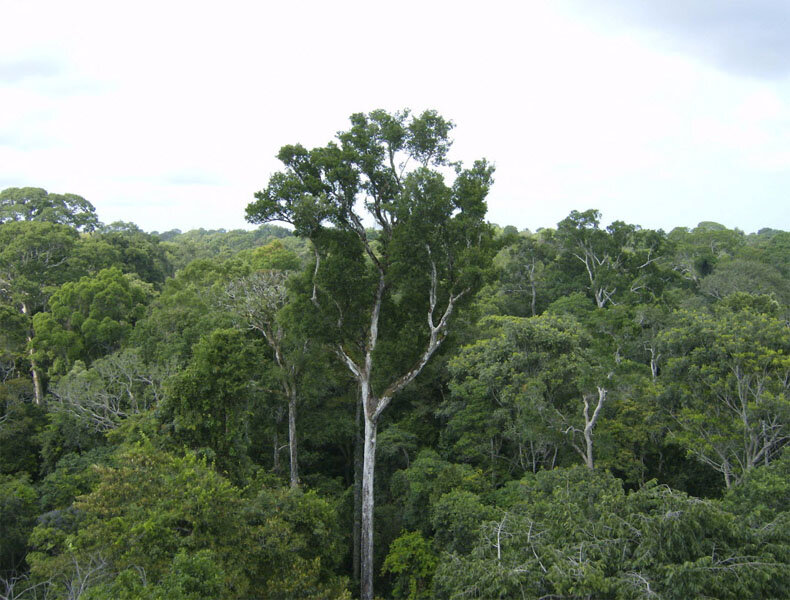Deforestation: Brazil is a success story for conservation
Loading...
Climate scientists link about 10 percent of annual global carbon increase to the effects of deforestation. But a new study points to a promising shift.
In the 1990s, tropical deforestation claimed 40 million acres each year, according to a report released in June by the Union of Concerned Scientists (UCS). Today, about 32 million acres of forests fall each year, a drop of about 19 percent.
Trees grow by absorbing carbon dioxide, locking it away in their roots, trunks, branches, and leaves, and emitting oxygen in return.
“These forests are the lungs of the earth,” says Glenn Hurowitz, managing director at Climate Advisers, a carbon policy advocacy organization.
But when the trees die, they stop sequestering carbon dioxide, and release almost all of it back into the atmosphere. “[T]here seemed to be virtually no way to turn the tide” of deforestation, the UCS report notes. “But today the overall picture looks considerably brighter.”
The report cites a number of efforts that have led to deforestation’s decline. The researchers looked primarily at political policies, incentive programs, and economic reforms, limiting the scope of their study to countries and regions that displayed clear, tangible successes.
“Ultimately, the report shows that every euro, dollar, peso, rupee, dong, and African franc invested in these programs and policies is money well spent,” said Doug Boucher, the lead author of the study, in a news release. “The rewards far outweigh the costs.”
Brazil has effectively employed a suite of conservation methods. The Amazon rain forest holds at least 40 tons of carbon per acre, according to UCS estimates.
“Part of what makes it such a good success is that efforts have gone across the full spectrum of actors,” says study coauthor Pipa Elias, a consultant to UCS. Citizens and nongovernmental organizations alike in Brazil have pressured businesses and the government to make changes. “Civil societies pressure companies to take action and then companies pressure governments to take action.”
The government has enacted a number of laws restricting deforestation, including those that expand protected areas and crack down on illegal logging. Although the private sector tends to be the most difficult to get on board, Ms. Elias says, the Brazilian beef and soy industries have agreed to a moratorium on cutting down more trees.
“I think Brazil in particular has realized that protecting forests is an essential ingredient to ensuring global market access for their products,” says Mr. Hurowitz, who was not involved in the study.
But there’s no straightforward recipe for success, says Elias. “What we found is that it’s very diverse in different places.” She explains that most regions need to consider their individual economic factors.
One initiative hailed by the authors as effective is REDD+, a mechanism created by the United Nations. The program, whose acronym stands for Reducing Emissions from Deforestation and Forest Degradation, channels funds from the developed countries’ private sectors to the developing world as an incentive for conservation.
Planting new trees is also crucial, says Elias. China has been hailed for its reforestation efforts, but these have typically taken the form of plantation-style monocultures, with little biodiversity, says Elias. She explained that China does not typically plant native trees, which research has shown is more successful.
Sustainable replanting programs incorporate knowledge of native species. Trees that like sun are planted first, and the shade lovers come later. These methods create homes for native animals, as well as even providing some sustainable timber.
“In most countries where that has happened on a large scale, it takes a crisis mode to make that happen,” says Elias about reforestation.
“We have to change our perception of what crisis mode is” so countries and regions feel the need to act sooner rather than later, she adds. Of great concern, for example: Indonesia, where deforestation has increased despite a government moratorium on felling trees in carbon-sequestering primary forests – and where official reporting has been suspect. Still, there is optimism.
“We usually cite 2020 as a goal at which deforestation doesn’t really need to be happening,” says Elias. Here, Elias is referring to net deforestation: If a company cuts trees to make a product, they would need to plant the same volume of trees in that location.
The UCS report discussed many tropical regions, including Brazil, Guyana, Madagascar, Kenya, India, Mexico, Vietnam, Costa Rica, Central Africa, El Salvador, Tanzania, and Mozambique.
“The report will demonstrate to slower-moving companies and countries that developing countries are taking action to protect their forests and prospering because of it. Having those global examples is irreplaceable,” says Hurowitz. “Deforestation is not inevitable.”






